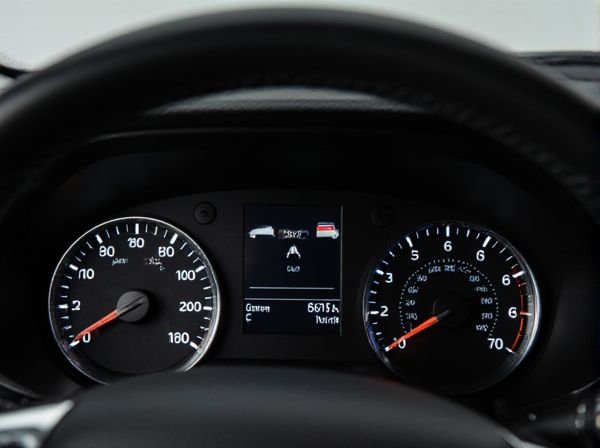
Photo illustration: Analog Temperature Gauge vs Digital Temperature Gauge
Analog temperature gauges provide a quick visual reference through a needle pointing to a temperature scale, making them easy to read in varying lighting conditions. Digital temperature gauges display precise numeric readings, offering higher accuracy and often additional features like alarms or data logging. Choosing between these depends on your need for simplicity versus detailed information in temperature monitoring.
Table of Comparison
| Feature | Analog Temperature Gauge | Digital Temperature Gauge |
|---|---|---|
| Display Type | Needle on dial | Numeric LCD/LED |
| Readability | Visual, approximate | Precise numeric value |
| Response Speed | Slower, mechanical | Faster, electronic sensor |
| Durability | Long-lasting, minimal failure | Depends on electronics, potential faults |
| Cost | Lower initial cost | Higher initial cost |
| Maintenance | Simple, rare | Requires sensor calibration |
| Precision | Approximate temperature | Exact temperature reading |
| Power Usage | Minimal, mechanical | Consumes more power |
Introduction to Temperature Gauges
Temperature gauges measure thermal conditions by displaying temperature readings critical for various applications in automotive, industrial, and HVAC systems. Analog temperature gauges use a dial and needle mechanism, often relying on bimetallic strips or thermocouples to translate temperature changes into mechanical movement. Digital temperature gauges utilize electronic sensors and digital displays, offering higher accuracy, faster response times, and easier readability compared to analog counterparts.
How Analog Temperature Gauges Work
Analog temperature gauges operate using a bimetallic strip or a Bourdon tube that physically deforms in response to temperature changes, causing a needle to move across a calibrated dial. The bimetallic strip consists of two metals with different expansion rates bonded together, which bends as temperature changes exert differential expansion, translating thermal variation into mechanical displacement. This mechanical motion is directly correlated to the temperature scale, providing a continuous and immediate reading without the need for electronic components.
How Digital Temperature Gauges Work
Digital temperature gauges use electronic sensors such as thermistors or thermocouples to measure temperature changes and convert them into electrical signals. These signals are processed by a microcontroller, which interprets the data and displays the temperature reading in a digital format on an LCD or LED screen. The precise electronic components provide faster, more accurate readings than analog gauges, which rely on mechanical movement and temperature-sensitive materials.
Accuracy: Analog vs Digital Temperature Gauges
Digital temperature gauges typically offer higher accuracy than analog gauges due to their precise electronic sensors and digital readouts, which minimize human error in reading values. Analog gauges rely on mechanical components such as bimetallic strips or liquid-filled tubes, which can be less precise and affected by environmental factors like vibration and wear. Calibration in digital gauges is often easier and more consistent, ensuring reliable temperature measurements across a wide range of applications.
Response Time and Display
Analog temperature gauges feature a continuous dial display that provides real-time visual feedback with rapid response times ideal for monitoring gradual temperature changes. Digital temperature gauges offer precise numerical readings with slightly slower response times but enhanced accuracy and ease of interpretation, especially in low-light conditions. The choice between analog and digital depends on whether quick visual cues or exact temperature values are prioritized.
Durability and Environmental Suitability
Analog temperature gauges often feature robust mechanical components that enhance their durability, making them well-suited for harsh environments with fluctuating temperatures and vibrations. Digital temperature gauges incorporate electronic sensors and LCD displays, which offer precise readings but may be more vulnerable to moisture, dust, and extreme temperature variations. Industrial applications requiring long-term reliability in rugged conditions frequently prefer analog gauges, while controlled environments benefit from the accuracy and ease of digital gauges.
Ease of Installation and Maintenance
Analog temperature gauges generally offer straightforward installation with simple wiring and minimal calibration requirements, making them user-friendly for quick setups. Digital temperature gauges require precise wiring and sometimes software configuration but provide easier maintenance through self-diagnostics and replaceable sensors. Both types benefit from clear user manuals, though analog models may require more frequent manual calibration to ensure accuracy.
Cost Comparison: Analog vs Digital
Analog temperature gauges generally cost less upfront, with prices ranging from $10 to $50 depending on quality and brand, making them budget-friendly options for basic temperature monitoring. Digital temperature gauges, priced between $20 and $150, offer advanced features such as precise readings, data logging, and backlit displays, which can justify the higher initial investment. Maintenance and long-term accuracy of digital gauges often result in better cost-efficiency over time, despite the higher purchase price compared to simpler analog models.
Applications and Industry Preferences
Analog temperature gauges are favored in automotive, HVAC, and industrial machinery applications due to their durability, simplicity, and ease of reading in harsh environments. Digital temperature gauges dominate industries requiring high precision and data logging capabilities, such as pharmaceuticals, food processing, and electronics manufacturing. Industry preferences hinge on application-specific needs: analog gauges for robust, quick visual checks, while digital gauges are chosen for accuracy, integration with control systems, and remote monitoring.
Conclusion: Choosing the Right Temperature Gauge
Selecting the right temperature gauge depends on accuracy needs, readability, and application environment. Analog temperature gauges offer simplicity and ease of use with clear visual feedback, making them suitable for quick glance monitoring in mechanical and industrial settings. Digital temperature gauges provide higher precision and advanced features, ideal for scientific, medical, and technology-driven applications requiring exact data and programmable alerts.
 caratoz.com
caratoz.com